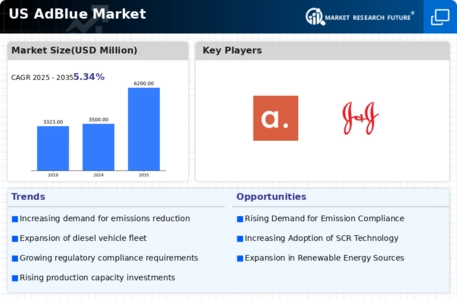Market Growth Projections
The Global US AdBlue Market Industry is poised for substantial growth, with projections indicating a market value of 3500 USD Million in 2024 and an anticipated increase to 6200 USD Million by 2035. This growth trajectory reflects a compound annual growth rate of 5.34% from 2025 to 2035, driven by various factors including regulatory compliance, technological advancements, and rising demand in the transportation sector. The market's expansion is indicative of the increasing reliance on AdBlue as a critical component in reducing emissions from diesel engines, highlighting its importance in the broader context of environmental sustainability.
Increasing Demand for Diesel Vehicles
The Global US AdBlue Market Industry experiences a notable surge in demand for diesel vehicles, which are equipped with selective catalytic reduction systems requiring AdBlue for optimal performance. As diesel vehicles become increasingly popular due to their fuel efficiency and lower CO2 emissions, the necessity for AdBlue rises correspondingly. In 2024, the market is projected to reach 3500 USD Million, driven by this growing vehicle segment. Furthermore, the trend towards stricter emissions regulations across various states further propels the demand for AdBlue, as manufacturers and consumers alike seek to comply with environmental standards.
Rising Awareness of Environmental Impact
There is a growing awareness among consumers and businesses regarding the environmental impact of diesel emissions, which is influencing the Global US AdBlue Market Industry. As stakeholders become more conscious of their carbon footprint, the adoption of AdBlue as a means to mitigate nitrogen oxide emissions gains traction. This shift in perception is likely to drive demand as both individuals and corporations prioritize sustainability. The increasing emphasis on corporate social responsibility and environmental stewardship suggests that the market for AdBlue will continue to expand, aligning with broader global sustainability goals.
Technological Advancements in SCR Systems
Technological advancements in selective catalytic reduction systems are pivotal for the Global US AdBlue Market Industry. Innovations in SCR technology enhance the efficiency of AdBlue usage, leading to reduced consumption and improved vehicle performance. As manufacturers invest in research and development, the integration of advanced SCR systems becomes more prevalent, thereby increasing the demand for AdBlue. This trend is likely to contribute to a compound annual growth rate of 5.34% from 2025 to 2035, indicating a robust growth trajectory for the market as these technologies become standard in new diesel vehicles.
Growth in Logistics and Transportation Sector
The logistics and transportation sector plays a crucial role in the Global US AdBlue Market Industry, as a significant portion of diesel consumption occurs within this domain. With the continuous expansion of e-commerce and freight transport, the demand for diesel-powered vehicles remains strong, subsequently increasing the need for AdBlue. The sector's growth is expected to further bolster the market, as companies seek to enhance their fleet efficiency while adhering to environmental regulations. This dynamic environment suggests a sustained demand for AdBlue, contributing to the overall market growth in the coming years.
Regulatory Compliance and Environmental Standards
The Global US AdBlue Market Industry is significantly influenced by stringent regulatory frameworks aimed at reducing nitrogen oxide emissions from diesel engines. The Environmental Protection Agency has established regulations that necessitate the use of AdBlue in diesel vehicles to meet these standards. As compliance becomes increasingly critical, the demand for AdBlue is expected to rise. By 2035, the market is anticipated to expand to 6200 USD Million, reflecting the industry's adaptation to evolving environmental policies. This regulatory landscape not only drives consumption but also encourages innovation in AdBlue production and distribution.













Leave a Comment